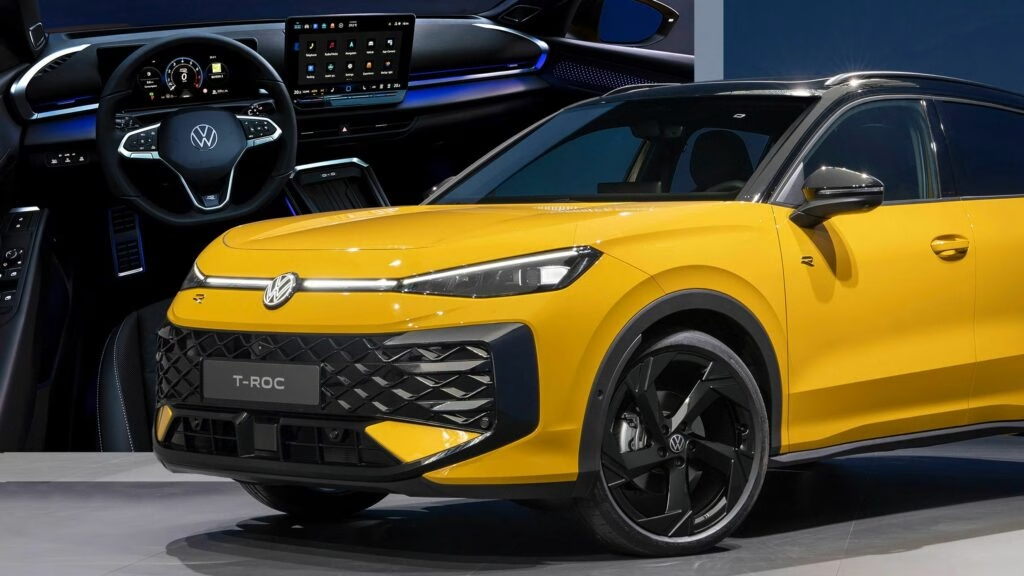How has Volkswagen changed the T-Roc for its second generation?
Volkswagen’s second-generation T-Roc doesn’t just tweak the formula—it reinvents it. The new model is noticeably larger, stretching 122 mm longer than before, and it wears a sharper, more modern look inspired by VW’s ID electric family. The front end ditches the traditional grille for a sleek, full-width LED bar and illuminated emblem, giving the T-Roc a futuristic vibe that stands out in a crowded crossover market. The side profile keeps the signature “hockey-stick” line, but the surfacing is cleaner, and the wheels now go up to a bold 20 inches. Around back, the coupe-like rear windshield and full-width taillights give it a sportier, more upscale feel.
But it’s not just about looks. VW has improved the T-Roc’s aerodynamics by 10%, dropping the drag coefficient to 0.29 cd. That’s not just a number—it means better efficiency and a quieter ride, especially at highway speeds. The new dimensions also help the T-Roc slot more comfortably between the smaller Taigo/T-Cross and the larger Tiguan/Tayron in VW’s European lineup, making it a true “Goldilocks” option for buyers who want something just right.
What’s new inside the T-Roc’s cabin?
Step inside, and you’ll notice the T-Roc has grown up. VW has ditched the hard plastics of the previous model for a more premium, fabric-structured dashboard, ambient lighting, and higher-quality materials throughout. There’s a real focus on sustainability, too—about 20% of the interior plastics are recycled, which is a meaningful step in a segment where eco-friendly touches are often just marketing fluff.
Tech takes center stage with a free-standing infotainment display (10.4 or 12.9 inches, depending on trim) and a crisp 10-inch digital instrument cluster. There’s even an optional head-up display. Some quirks remain, like the touch sliders for climate and volume controls, but VW has listened to feedback and kept physical buttons on the steering wheel. Plus, the rotating knob borrowed from the Tiguan makes switching between volume, drive modes, and ambient settings a breeze.
Comfort hasn’t been overlooked. The optional ergoActive seat offers 14-way adjustment and a massage function—something you’d expect in a luxury SUV, not a compact crossover. And if you’re an audiophile, the available Harman Kardon sound system is a treat.
How does the T-Roc handle safety and driver assistance?
VW’s latest T-Roc comes loaded with advanced driver assistance features. The updated Travel Assist system now supports automatic lane changes and has smarter predictive speed control, making long drives less stressful. There’s also a new exit warning system to help prevent dooring cyclists or passing cars, and the Park Assist Pro can park the car automatically for up to 50 meters—perfect for tight city spots or those days when parallel parking just isn’t happening.
Space and practicality: Is the new T-Roc family-friendly?
Absolutely. The larger footprint means more legroom for taller passengers, and the boot has grown to 465 liters—enough for a couple of big suitcases or a week’s worth of groceries. That’s a 20-liter improvement over the old model, and it puts the T-Roc right in the sweet spot for small families or anyone who needs a bit more flexibility from their daily driver.
What are the engine options, and what’s new on the electrification front?
Here’s where things get interesting. The T-Roc rides on VW’s updated MQB Evo platform, which allows for a mix of powertrains. At launch, you’ll find two versions of the mild-hybrid 1.5-liter eTSI engine: one with 114 hp and another with 148 hp, both paired to a seven-speed DSG and a 48V system that can add a temporary 19 hp boost. These setups are front-wheel drive for now, but a more powerful 2.0-liter TSI (with available all-wheel drive) is on the way.
The big news is the introduction of full-hybrid technology—a first for the VW Group in this segment. The new hybrid system pairs a 1.5-liter TSI evo2 engine with a front-mounted electric module and a lithium-ion battery under the rear seats. You’ll get either 134 hp or 168 hp, and a healthy 306 Nm of torque in both cases. This move signals VW’s commitment to electrification, even as it continues to offer traditional gasoline options.
When can you get the new T-Roc, and how popular is it?
VW plans to launch the new T-Roc in Europe this November, with pre-sales starting at the end of August. Pricing details are still under wraps, but expect it to be competitive given the T-Roc’s track record—over 2 million units sold since 2017, and nearly 300,000 last year alone. That makes it VW’s second best-selling SUV, just behind the Tiguan.
What’s the real-world impact of these changes?
The new T-Roc isn’t just a facelift—it’s a thoughtful evolution that addresses real customer needs. The improved space, smarter tech, and new hybrid options make it more versatile and future-proof. VW’s focus on sustainability and comfort shows they’re listening to what drivers actually want, not just what looks good on a spec sheet.
The big takeaway? The 2026 VW T-Roc isn’t about perfection—it’s about smarter adjustments. Start with one change this week, and you’ll likely spot the difference by month’s end. Whether it’s a more comfortable commute, a greener footprint, or just a little more fun behind the wheel, the T-Roc’s updates are designed to make everyday driving just that bit better.

